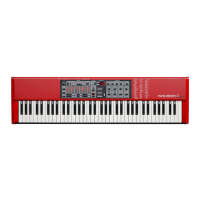A crossfades first section is indicated with the light blue area that is
before the loop start, to the left of the blue area. The crossfades end
section is the darkest area immediately to the left of the loop end marker.
As these settings are changed by you, the indication in the graph will
change as well.
You can set the position of the loop start marker by clicking anywhere in
the graph. If you right-click to the right of the loop start marker, you can
set a new loop end marker – and change the actual loop length.
View Trim
The graph in the Sample Loop/Stop tab can be augmented with a more
detailed display of the waveform at the loop start and the loop end mark-
ers. This is activated by checking the View Trim box at the lower, left
corner of the Editor window.
The red waveform shows the audio immediately before and at the loop
end marker. The green waveform is the audio at, and immediately after
the loop start marker. If these two waveforms meet at the same level,
chances are good that this will indicate a loop without any clicks in it.
If a crossfade is used, the two waveforms will be superimposed on top
of each other, like the illustration above. This provides a nice visual con-
firmation of what happens if you fine-tune the length.
Start with the crossfade set to a small value and see how these two
waveforms are presented. When the two colored peaks and valleys
are in phase with each other, chances are good that you have a
pretty good loop. Any changes you do can always be monitored in
real time if you activate the playback.
Loop Options
There are three available loop options: Long Loop which is the default
loop that is applied to a sample when it is assigned to a zone, Short
Loop which creates a loop with a single waveform period and finally the
No Loop, which gives you an opportunity to set an end marker to the
sample.
Loop Start
You can enter a loop start position expressed in seconds in the value
box, confirming this by pressing enter, using the slider or fine-tune the
position with the increment/decrement buttons. Clicking in the graph will
also position the loop start marker.
Long Loop
This section contains the settings for the Long Loop parameters.
Length
You can enter a loop length
expressed in seconds in the value
box, confirming this by pressing
enter, using the slider or set the
length with the increment/decre-
ment buttons, in a coarse- or a
fine-tune fashion.
Right-clicking in the graph will position the loop end marker, which
together with the position of the loop start marker sets the loop length.
Make sure that you right-click to the right of the loop start, it is not pos-
sible to position the loop end before the loop start marker.
Xfade
You can enter a crossfade length expressed in seconds in the value
box, confirming this by pressing enter or by using the slider. Any
changes you do will be immediately heard if you are playing back the
sample and also presented in the waveform graph. To disable the
crossfade, set the crossfade length to 0.
Xfade Curve
There are three available curves for the crossfade: Log1, Log2, and
Linear. These are used to compensate for any amplitude changes that
might occur in a crossfade as a result of cancellations when harmonics
are out of phase with each other.
Short Loop
When using the Short Loop option, the loop length is set to a single
waveform period. As the length of a single period is relative to the pitch
of the sample, you can use an algorithm that analyzes the pitch of the
sample, or use a length correlating to the pitch of the sample’s Root Key.
Loop Length based on
These are the two alternatives on how to deter-
mine what constitutes as a single period in the
sample. If a short loop produces a different pitch
than the actual sample, you may need to try the
Root Key option.
The Pitch Estimate is the default, but there may be occasions when
this is unsuitable. If a sample has strong harmonics (that are stronger
than the fundamental), the Root Key option may be better suited.
Xfade
The short loop also has provisions for using a crossfade, with a selec-
tion of fixed lengths: 25% or 10% of the loop length. Set this to Off if no
crossfade should be used.
No Loop
This provides you with the option to set a marker where the sample will
end. You can also set a fade out time.
Stop
You can enter the position of where the sample
will end expressed in seconds in the value box,
confirming this by pressing enter or by using
the slider. You can also click in the graph to set
the sample end marker when this loop option is
selected.
Fade Out
Enter the Fade Out time expressed in seconds in the value box, con-
firming this by pressing enter or by using the slider. This is the time in
seconds leading up to the sample end during which the amplitude will
gradually fade out.
Apply on All
The loop settings that you have made can be applied to all other
samples in the project. In order to compensate for any artifacts that
might occur when you e.g. play a chord, as a result of several loops
with identical settings, you have the option to apply a variation to the
loop length.

